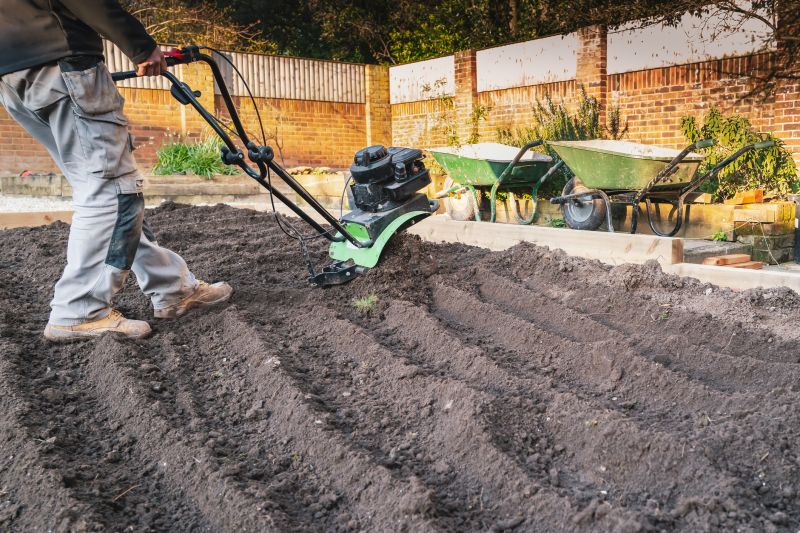Expert Picks for Lawn Rototilling Tools That Deliver Professional Results
Choose from our curated list of reliable rototillers that help you prepare your soil with precision and ease.
 Lawn rototillers are essential tools for transforming compacted or overgrown soil into a workable, aerated foundation suitable for planting or landscaping. They come in a variety of designs and sizes to accommodate different yard sizes and soil conditions. Whether you're preparing a small garden bed or a large plot of land, selecting the right rototiller can make the task more manageable and efficient. These machines typically feature rotating blades or tines that loosen and turn the soil, helping to break up clumps and incorporate amendments with ease.
Lawn rototillers are essential tools for transforming compacted or overgrown soil into a workable, aerated foundation suitable for planting or landscaping. They come in a variety of designs and sizes to accommodate different yard sizes and soil conditions. Whether you're preparing a small garden bed or a large plot of land, selecting the right rototiller can make the task more manageable and efficient. These machines typically feature rotating blades or tines that loosen and turn the soil, helping to break up clumps and incorporate amendments with ease.
Top Overall Option
All-Purpose Garden Tiller
An all-purpose garden tiller designed to handle a variety of soil conditions with adjustable depth and width settings. Its versatile power options and ergonomic design make it suitable for small to medium-sized projects, offering a reliable solution for preparing garden beds and landscaping tasks.
Types of Products For Lawn Rototillings
Electric Corded Tillers
Lightweight and easy to operate, ideal for small gardens and yard work where mobility isn't a concern.
Battery-Powered Tillers
Offers cordless convenience with moderate power, suitable for medium-sized projects and easy storage.
Gas-Powered Tillers
Provides high power and mobility for larger areas and tougher soil conditions, suitable for extensive landscaping tasks.
Mini Tillers
Compact and lightweight, perfect for small beds, flower gardens, and tight spaces.
Heavy-Duty Tillers
Designed for professional or extensive use, capable of breaking through hard, compacted soil.
Front-Tine Tillers
Features tines located at the front, offering better maneuverability for tilling in tight spaces.
Rear-Tine Tillers
Provides more power and stability, ideal for larger or tougher soil conditions.
Walk-Behind Tillers
Operated by pushing, suitable for medium to large gardens requiring extensive tilling.
Stand-On Tillers
Allows the operator to stand while tilling, reducing fatigue during prolonged use.
Adjustable Tine Tillers
Features adjustable tines for customizing tilling depth and width according to project needs.
Popular Choices
Popular for their portability and ease of use in small to medium gardens, without the hassle of cords.
Favored for larger projects requiring more power and mobility, suitable for extensive landscaping tasks.
Chosen for tight spaces and small beds, offering lightweight operation with sufficient tilling capability.
Preferred for tough soils and large-scale projects, providing robust performance for demanding tasks.
Ideal for quick, light-duty tasks around the yard, appreciated for their quiet operation and low maintenance.
Popular for their balance of power and convenience, suitable for medium-sized gardens without cord restrictions.
Often selected for their maneuverability in small or tight garden spaces.
Favored for their versatility in customizing tilling depth for different soil and planting requirements.
Increasingly popular for reducing fatigue during extensive tilling sessions, especially for professional landscapers.
When choosing a rototiller, consider the power source, as options include electric, gas-powered, and battery-operated models. Gas-powered tillers generally offer more power and mobility, making them suitable for tougher soils and larger areas. Electric models tend to be quieter and require less maintenance, ideal for smaller projects or urban settings. Battery-operated tillers provide a balance between portability and power, with the convenience of cordless operation. Additionally, the width and depth of tilling, weight, and maneuverability are important factors to ensure the equipment suits your specific needs.
Maintenance and safety features are also critical considerations. Look for models that offer easy access to parts for servicing, safety shields to prevent debris ejection, and ergonomic handles to reduce user fatigue. Some tillers come with adjustable tines or multiple speed settings, providing greater control for different soil conditions. Properly selecting a rototiller involves balancing power, size, and features to match your gardening ambitions and physical capabilities, ensuring a smooth and productive tilling experience.
Key Buying Considerations
- Power source (electric, battery, gas) based on project size and mobility needs.
- Tilling width and depth to match the size and soil conditions of your garden.
- Weight and maneuverability for ease of use, especially if you have physical limitations.
- Durability and build quality for handling tough soil and frequent use.
- Ease of maintenance, including accessibility of parts and availability of replacement components.
- Safety features such as shields, automatic shut-off, and ergonomic handles.
- Adjustability of tines and settings for customizing tilling performance.
- Noise levels, especially if working in noise-sensitive environments.
- Storage and portability considerations for compact spaces or limited storage areas.
- Price range and warranty options to ensure long-term satisfaction.
- Compatibility with additional attachments or accessories for expanded functionality.
- User reviews and feedback to gauge real-world performance and reliability.
- Availability of customer support and service from the manufacturer.
- Ease of assembly and setup for quick start-up.
- Environmental conditions and soil types to ensure the tiller can handle your specific needs.
